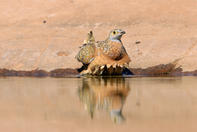
Name
Burchell’s Sandgrouse - Pterocles burchelli
Burchell’s Sandgrouse Appearance
Burchell's sandgrouse have light brown to rufous plumage, that is mottled with dark brown and white spots. Males have a grey throat and cheeks, whilst females have a yellow throat and cheeks. The eye is surrounded by a bare yellow patch of skin. The eye and bill are both dark in colour.
Burchell's sandgrouse are around the same size as a pigeon at 25 cm in length, with females being slightly smaller than the males.
Burchell’s Sandgrouse Diet
Burchell's sandgrouse feed exclusively on small seeds.
Burchell’s Sandgrouse Breeding
Burchell's sandgrouse are monogamous. Both parents incubate their two or three eggs, which are laid in a shallow scrape or depression. The chicks are precocial, but they are unable to fly for around one month from hatching, they are, however, able to run with their parents. Both parents care for their young.
Burchell’s Sandgrouse Behaviour
As with all sandgrouse, they will carry water to their chicks by means of their belly feathers. As the chicks cannot fly, the parents need to supply the chicks with moisture. After soaking their chest and belly feathers in water, the male will fly to the nest and chicks to enable the chicks to drink. This is also done by the female, but to a lesser extent, due to the female not have the same amount of absorbent feathers as the male.
Burchell's sandgrouse time their drinking with sunrise throughout the year, they arrive at a water hole to drink and collect water, around 2 hours after sunrise. Burchell’s sandgrouse form flocks to drink.
Threats
None, The Burchell's sandgrouse is common across its range.
Burchell’s Sandgrouse Distribution and Habitat
The Burchell's sandgrouse is a near endemic to South Africa. They are found mostly on the Kalahari sands, in arid or semi-arid areas. The Burchell's sandgrouse can be found in the Northern Cape in South Africa.